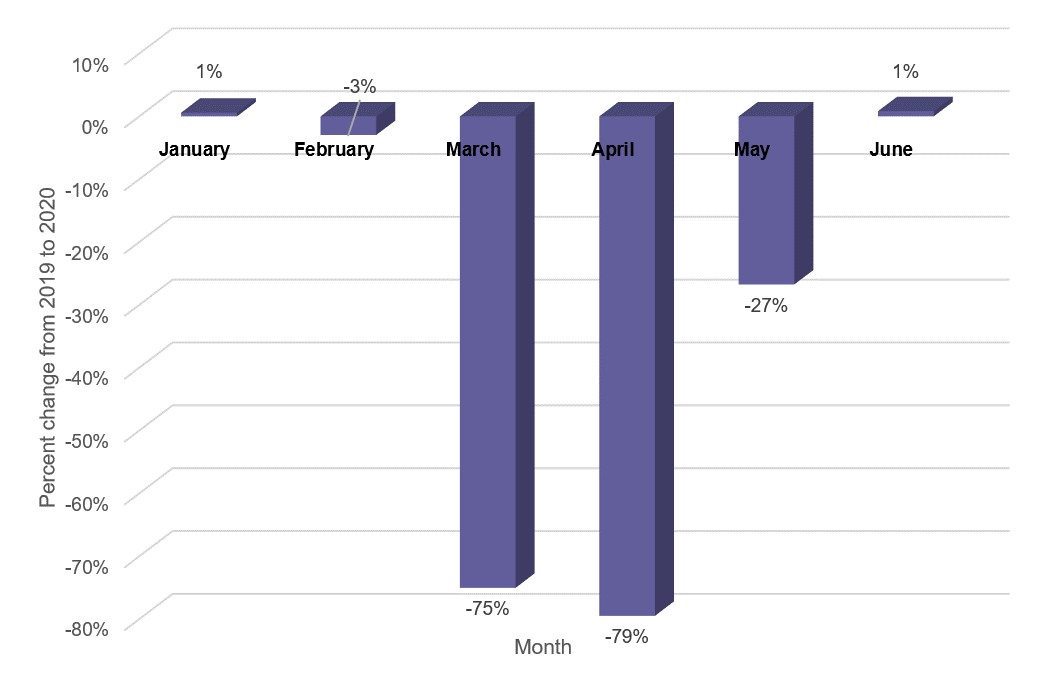Article
Contributor: FAIR Health Study Reveals Impact of COVID-19 Pandemic on Dental Services
Author(s):
A FAIR Health review finds a dramatic drop in dental claims in March and April 2020 due to COVID-19.
Use of privately insured dental services fell 75 percent in March 2020 and 79% in April 2020 compared to the same months the year before, showing the impact of the COVID-19 pandemic, according to a new FAIR Health study (FIGURE 1). The fifth in FAIR Health’s series of COVID-19 briefs, the study is entitled Dental Services and the Impact of COVID-19: An Analysis of Private Claims.
FIGURE 1. Monthly Percent Change in Utilization of Dental Services from 2019 to 2020, Nationally

March and April 2020 were months when the COVID-19 pandemic first became rampant in the United States, prompting many states to ban elective dental procedures. In May 2020, when states began to lift these bans, dental service utilization still declined compared to May 2019, but only by 27%. In June 2020, there was a 1% increase in utilization compared to June 2019.
In this study, FAIR Health delves into its database of private healthcare claims, the largest in the nation. FAIR Health compares dental service utilization in the first 6 months of 2020 to the first 6 months of 2019. The analysis is striated by age, state and procedure code, as well as by dental-related diagnoses in urgent care centers and emergency departments (EDs). Among the other key findings:
In the period January-June 2020, patients 22 years of age or younger accounted for a larger percentage of dental services than in the same months the year before. Patients 14 years of age or younger and patients aged 14-22 each accounted for 2% more than in January-June 2019.
From June 2019 to June 2020, changes in dental service utilization varied greatly by age group. The youngest (22 and younger) and oldest (55 and older) age groups increased in utilization, while those in the middle (ages 23-54) decreased.
All states in March and April 2020 exhibited some degree of decrease in dental service utilization compared to the corresponding months in 2019 (FIGURE 2). The 5 largest decreases were in the Northeast and Midwest. The five smallest decreases were in the West in March and in the West and South in April.
FIGURE 2. Percent Change in Utilization of Dental Services from March 2019 to March 2020, by State

In June 2020, many states showed an increase in dental service utilization from the previous June, while other states decreased. The 5 largest decreases were in the Northeast and Midwest, the 5 largest increases in the West and South.
From March and April 2019 to March and April 2020, comprehensive oral evaluations for new or established patients (D01501) fell from 8th or 9th place among the most common dental procedures to 10th or 12th.
Certain other procedures rose in utilization. Problem-focused, limited oral evaluations (D0140) rose from 11th place in March and April 2019 to 5th place in March 2020 and 4th place in April 2020.
One procedure that rose to an even greater extent was the unspecified preventive procedure, by report (D1999), which, during the pandemic, was recommended for use to seek payment for the cost of additional personal protective equipment. It rose from number 366 in June 2019 to number 4 in June 2020.
Dental procedures differed in how much of a rebound they showed in June 2020 as compared to June 2019. For problem-focused, limited oral evaluations (D0140), all age groups increased above their June 2019 levels. For comprehensive oral evaluations for new or established patients (D0150), no age group recovered to the level of the previous year’s utilization.
From January and February 2020 to March and April 2020, dental caries (tooth decay or cavities) rose from fifth to fourth most common dental-related diagnosis presenting in urgent care centers and ERs.
The COVID-19 pandemic has had a profound impact on the healthcare system, including the dental industry. As with past studies in our COVID-19 series, FAIR Health presents this information in the hope that it will be useful to stakeholders throughout the healthcare sector, particularly dentists and other oral healthcare providers, as well as payors, policy makers and researchers.
This is the fifth in a series of briefs released by FAIR Health on the COVID-19 pandemic. The first brief examined projected US costs for COVID-19 patients requiring inpatient stays, the second the impact of the pandemic on hospitals and health systems, the third the impact on healthcare professionals, and the fourth key characteristics of COVID-19 patients.
For the new brief,click here.
Author Information
Robin Gelburd, JD, is the President of FAIR Health, a national, independent nonprofit organization with the mission of bringing transparency to healthcare costs and health insurance information. FAIR Health possesses the nation’s largest collection of private healthcare claims data, which includes over 32 billion claim records contributed by payors and administrators who insure or process claims for private insurance plans covering more than 150 million individuals. Certified by the Centers for Medicare & Medicaid Services (CMS) as a national Qualified Entity, FAIR Health also receives data representing the experience of all individuals enrolled in traditional Medicare Parts A, B and D; FAIR Health includes among the private claims data in its database, data on Medicare Advantage enrollees. Gelburd is a nationally recognized expert on healthcare policy, data and transparency.
Notes
1. The Code on Dental Procedures and Nomenclature is published in Current Dental Terminology (CDT), American Dental Association (ADA). All rights reserved.





